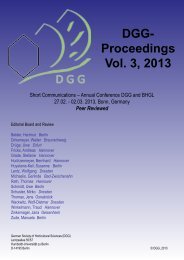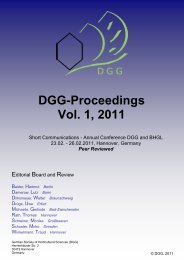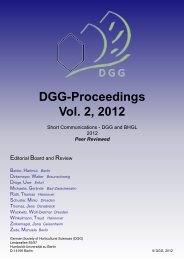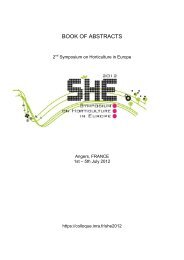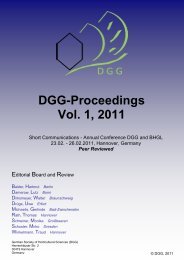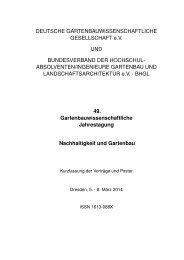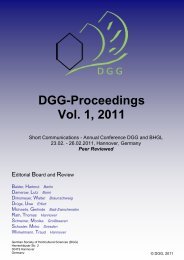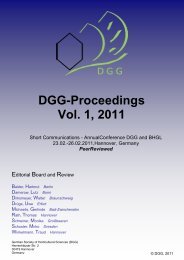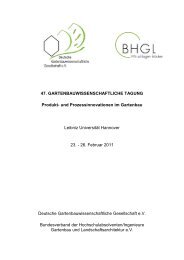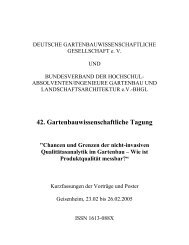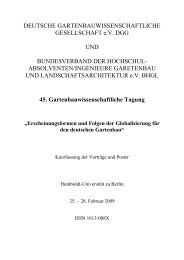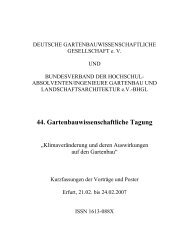43. Gartenbauwissenschaftliche Tagung - (DGG) und des
43. Gartenbauwissenschaftliche Tagung - (DGG) und des
43. Gartenbauwissenschaftliche Tagung - (DGG) und des
Erfolgreiche ePaper selbst erstellen
Machen Sie aus Ihren PDF Publikationen ein blätterbares Flipbook mit unserer einzigartigen Google optimierten e-Paper Software.
182<br />
Gemüsebau<br />
Effect of N-specification and mycorrhiza inoculation on growth and<br />
composition of Chinese chive<br />
H. Perner 1 , D. Schwarz², A. Krumbein² <strong>und</strong> E. George 1,2<br />
1<br />
Department of Plant Nutrition, Humboldt University of Berlin, 10115 Berlin, Germany<br />
²Institute of Vegetable and Ornamental Crops, Department of Plant Nutrition,<br />
14979 Großbeeren, Germany.<br />
perner@igzev.de<br />
Introduction<br />
Allium species are grown for their health related and flavor compo<strong>und</strong>s. The compo<strong>und</strong>s are<br />
influenced by sulfur and nitrogen supply. Most soils have sufficient sulfur, but high nitrate<br />
fertilization may decrease plant sulfate uptake. Allium plants can be highly dependent on mycorrhizal<br />
colonisation for satisfactory growth. These relations were tested on Chinese chive<br />
[Allium tuberosum Rottler ex Sprengel]. Three different ratios of ammonium nitrate supply in<br />
combination with AM fungi were tested in terms of growth, nutrient composition, and plant<br />
health related organo sulfur compo<strong>und</strong>s, measured indirectly as pyruvic acid.<br />
Material and Methods<br />
The experiment was carried out in a growth chamber for a period of 3 months, using Perlite as<br />
a substrate with application of a third-strength modified Hoagland solution. Nitrogen was<br />
provided at an ammonium nitrate (NH4:NO3) ratio of 95:5, 50:50, or 5:95. The substrate was<br />
inoculated with a commercial inoculum (AM), (TerraVital Hortimix, Plantworks Ltd., UK).<br />
Non-mycorrhizal (NAM) treatments were supplied with autoclaved inoculum and AM free<br />
filtrate. Each treatment had four replicates. Mycorrhizal colonisation of roots was determined.<br />
Results and Discussion<br />
Inoculation resulted in colonization rates of 43% of total root length for the highest nitrate<br />
supply, decreasing with increasing ammonium supply. Mycorrhizal colonization increased<br />
shoot S-concentrations, but did not significantly increase shoot dry weight, shoot N-, P-, NO3 -<br />
-concentrations, and pyruvic acid concentration. An NH4:NO3 ratio of 95:5 strongly reduced<br />
plant dry weight. In contrast, the plants grown with an NH4:NO3 ratio of 50:50 had similar<br />
shoot dry weight and increased N- and pyruvic acid concentrations as with an NH4:NO3 ratio<br />
of 5:95. Therefore, we conclude that the supply of an NH4:NO3 ratio of 50:50 is preferential<br />
for Chinese chive to produce high contents of health related organo sulfur compo<strong>und</strong>s.<br />
BHGL – <strong>Tagung</strong>sband 24/2006



